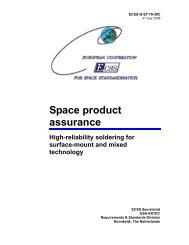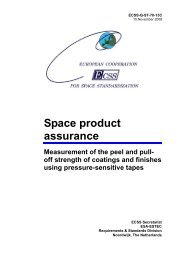ECSS-Q-70-03A (7 April 2006)
ECSS-Q-70-03A (7 April 2006)
ECSS-Q-70-03A (7 April 2006)
You also want an ePaper? Increase the reach of your titles
YUMPU automatically turns print PDFs into web optimized ePapers that Google loves.
<strong>ECSS</strong>-Q-<strong>70</strong>-<strong>03A</strong><br />
7 <strong>April</strong> <strong>2006</strong><br />
complementary cleaning procedure shall be applied, for instance,<br />
ultrasonic cleaning or scrubbing.<br />
8. Thorough rinsing in deionized or distilled water.<br />
b. The above cleaning sequence may be performed using different solutions<br />
from the ones indicated, provided that the prepared surface is fully<br />
degreased, etched, and free of particles and residues.<br />
A.5 Anodizing process set-up<br />
A.5.1 Hardware<br />
Cathode materials should be either lead or aluminium.<br />
Any metallic part of a suspension device that makes contact with the<br />
electrolyte shall be of aluminium or titanium.<br />
Workpieces shall be suspended in such a way that good electrical contact is<br />
maintained throughout the treatment.<br />
A.5.2 Anodizing bath composition<br />
The anodizing electrolyte shall consist of a solution of sulphuric acid 150 g/l in<br />
deionized or distilled water. During the lifetime of the electrolyte, it shall be<br />
kept within the limits given in Table A-2.<br />
Table A-2: Anodizing electrolyte composition limits.<br />
Chemical species Requirement<br />
Sulphuric acid H2SO4 120 g/l to 180 g/l<br />
Chloride Lower than the equivalent of 0,2 g NaCl/l<br />
Aluminium content Lower than 3 g/l<br />
Fluorine content Lower than 0,001 g/l<br />
A.5.3 Experimental parameters<br />
A.5.3.1. Temperature<br />
a. The bath temperature during anodizing shall be kept within the<br />
manufacturer’s specification.<br />
b. Air agitation of the electrolyte shall be sufficient to keep the specimen to<br />
electrolyte temperature difference below 0,5 °C.<br />
A.5.3.2. Current<br />
Current density shall be between 1 A/dm2 and 2 A/dm2 .<br />
A.5.3.3. Duration<br />
Anodizing time shall be set to give a thickness of the anodic film that fulfils the<br />
project requirements in terms of surface optical properties, corrosion and wear<br />
resistance. Typical thicknesses can range from 10 to 35 microns. The thickness<br />
can be estimated from the following formula:<br />
( current density)(<br />
time)<br />
= thickness<br />
(1)<br />
3,<br />
22<br />
with<br />
• current density expressed in A/dm2 • time expressed in minutes<br />
• thickness expressed in µm.<br />
27
















